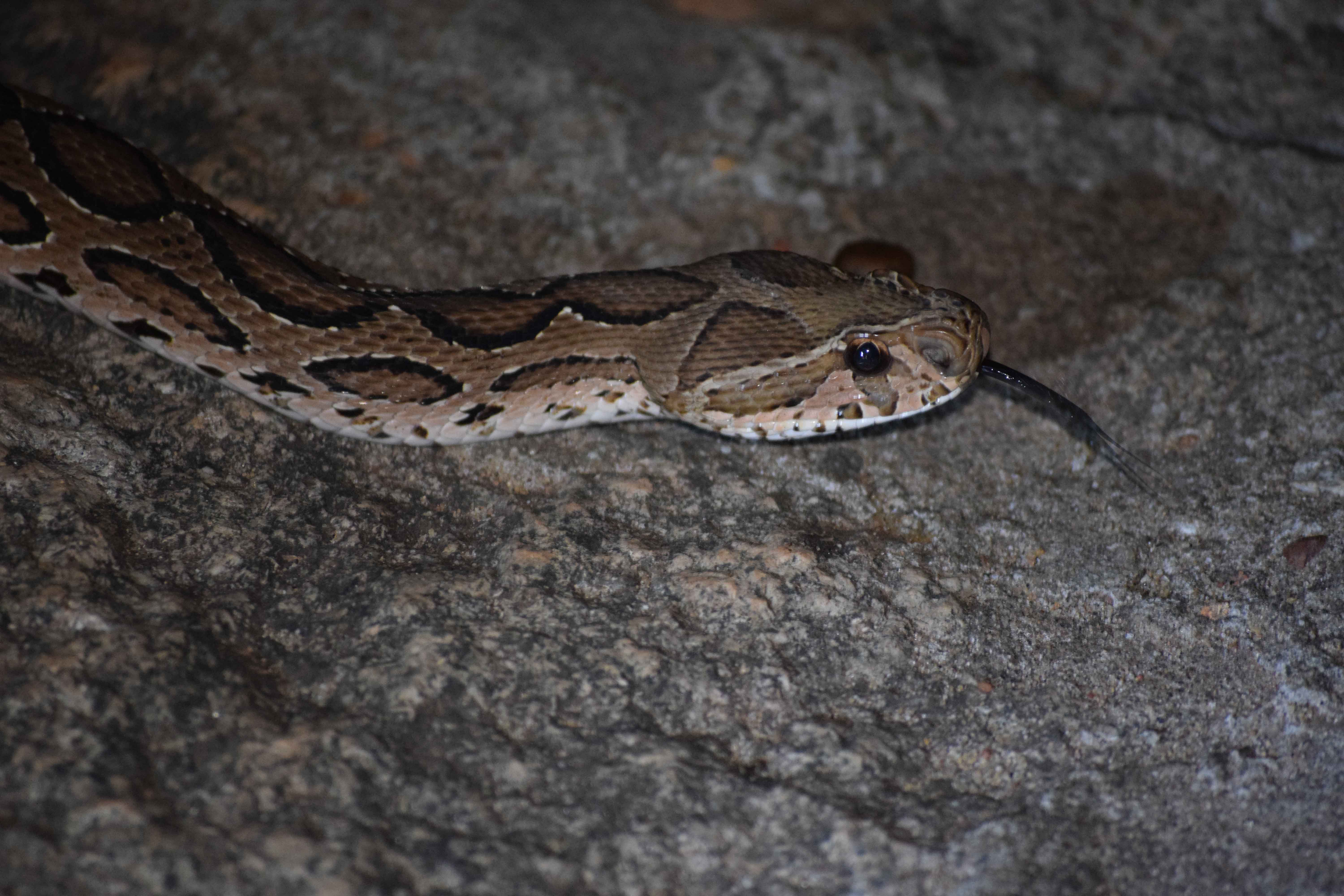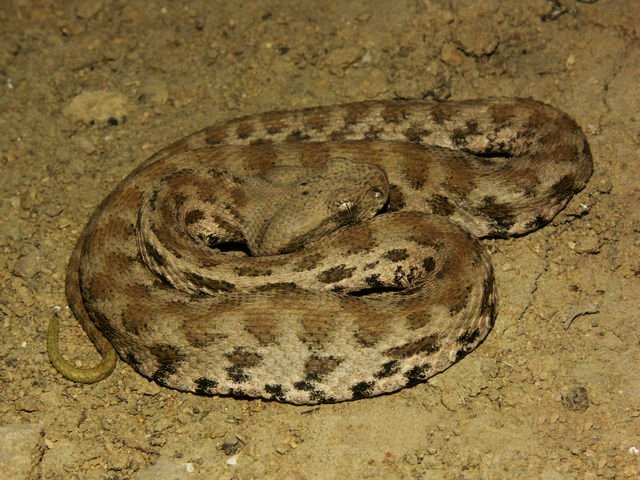|
Daboia
''Daboia'' is a genus of vipers.. Species The following four species are recognized as being valid: *'' Daboia mauritanica'' – Moorish viper *'' Daboia palaestinae'' – Palestine viper *''Daboia russelii'' – Russell's viper *''Daboia siamensis'' – eastern Russell's viper In the future, more species may be added to ''Daboia''. Obst (1983) reviewed the genus and suggested that it be extended to include '' Macrovipera lebetina'', '' Daboia palaestinae'', and '' M. xanthina''. Groombridge (1980, 1986) united ''V. palaestinae'' and ''Daboia'' as a clade based on a number of shared apomorphies In phylogenetics, an apomorphy (or derived trait) is a novel character or character state that has evolved from its ancestral form (or plesiomorphy). A synapomorphy is an apomorphy shared by two or more taxa and is therefore hypothesized to hav ..., including snout shape and head color pattern. Lenk et al. (2001) found support for this idea based on molecular evidence, suggestin ... [...More Info...] [...Related Items...] OR: [Wikipedia] [Google] [Baidu] |
Daboia Russelii
Russell's viper (''Daboia russelii)'' is a species of highly venomous snake in the family Viperidae. The species is native to South Asia. It was described in 1797 by George Shaw and Frederick Polydore Nodder. It is named after Patrick Russell. Known for its extremely painful bite, it is considered one of the most dangerous big four snakes in India. Taxonomy English naturalist George Shaw—with illustrator Frederick Polydore Nodder—in ''The Naturalist's Miscellany: Or, Coloured Figures Of Natural Objects; Drawn and Described Immediately From Nature'' formally described the species in 1797 as ''Coluber russelii'', from a specimen presented to the British Museum by Scottish herpetologist Patrick Russell. Russell had written of the species in his 1796 work ''An account of Indian serpents, collected on the coast of Coromandel'', confirming its highly venomous nature by experimenting on chickens and dogs. He added the native people called it ''katuka retula poda''. Analysis ... [...More Info...] [...Related Items...] OR: [Wikipedia] [Google] [Baidu] |
Daboia Siamensis
''Daboia siamensis'' (Common name: eastern Russell's viper,''Daboia russelii siamensis'' a Munich AntiVenom INdex (MAVIN) Accessed 23 October 2006. Siamese Russell's viper,John M. Mehrtens, Mehrtens JM (1987). ''Living Snakes of the World in Color''. New York: Sterling Publishers. 480 pp. . #Common names, more) is a Viperinae, viper species, which is Endemism, endemic to parts of Southeast Asia, southern China and Taiwan. It was formerly considered to be a subspecies of ''Daboia russelii'' (as ''Daboia russelli siamensis''), but was elevated to species status in 2007. ...
|
Daboia
''Daboia'' is a genus of vipers.. Species The following four species are recognized as being valid: *'' Daboia mauritanica'' – Moorish viper *'' Daboia palaestinae'' – Palestine viper *''Daboia russelii'' – Russell's viper *''Daboia siamensis'' – eastern Russell's viper In the future, more species may be added to ''Daboia''. Obst (1983) reviewed the genus and suggested that it be extended to include '' Macrovipera lebetina'', '' Daboia palaestinae'', and '' M. xanthina''. Groombridge (1980, 1986) united ''V. palaestinae'' and ''Daboia'' as a clade based on a number of shared apomorphies In phylogenetics, an apomorphy (or derived trait) is a novel character or character state that has evolved from its ancestral form (or plesiomorphy). A synapomorphy is an apomorphy shared by two or more taxa and is therefore hypothesized to hav ..., including snout shape and head color pattern. Lenk et al. (2001) found support for this idea based on molecular evidence, suggestin ... [...More Info...] [...Related Items...] OR: [Wikipedia] [Google] [Baidu] |
Daboia Palaestinae
''Daboia palaestinae'', also known as the Palestine viper,Mallow D, Ludwig D, Nilson G. 2003. ''True Vipers: Natural History and Toxinology of Old World Vipers.'' Malabar, Florida: Krieger Publishing Company. 359 pp. .Mehrtens JM. 1987. ''Living Snakes of the World in Color.'' New York: Sterling Publishers. 480 pp. . is a viper species endemic to the Levant. Like all vipers, it is venomous. It is considered a leading cause of snakebite within its range.U.S. Navy. 1991. ''Poisonous Snakes of the World.'' US Govt. New York: Dover Publications Inc. 203 pp. . No subspecies are currently recognized. Description It grows to an average total length (body + tail) of , with a maximum total length of . The head is triangular, distinct from the neck and covered by small scales. The upper part of the body is colored by large dark rhomboid blotches sometimes forming a zig-zag pattern. The harmless coin-marked snake, which lives in the same areas as the Palestine viper, resembles it in leng ... [...More Info...] [...Related Items...] OR: [Wikipedia] [Google] [Baidu] |
Macrovipera Deserti
The Moorish viper (''Daboia mauritanica'' or ''Macrovipera mauritanica''; common names: Moorish viper,Mallow D, Ludwig D, Nilson G. 2003. True Vipers: Natural History and Toxinology of Old World Vipers. Krieger Publishing Company, Malabar, Florida. 359 pp. . Sahara rock viper,U.S. Navy. 1991. Poisonous Snakes of the World. US Govt. New York: Dover Publications Inc. 203 pp. . Atlas blunt-nosed viper,Mehrtens JM. 1987. Living Snakes of the World in Color. New York: Sterling Publishers. 480 pp. . more) is a viper species found in northwestern Africa. No subspecies are currently recognized. Description Reaches a maximum length of 180 cm.Spawls S, Branch B. 1995. The Dangerous Snakes of Africa. Ralph Curtis Books. Dubai: Oriental Press. 192 pp. . Common names Moorish viper, Sahara rock viper, Atlas blunt-nosed viper, Atlas adder,Brown JH. 1973. Toxicology and Pharmacology of Venoms from Poisonous Snakes. Springfield, Illinois: Charles C. Thomas. 184 pp. LCCCN 73-229. . moun ... [...More Info...] [...Related Items...] OR: [Wikipedia] [Google] [Baidu] |
Macrovipera Lebetina
''Macrovipera lebetinus'', known as the blunt-nosed viper, Lebetine viper, Levant viper,Mallow D, Ludwig D, Nilson G. 2003. ''True Vipers: Natural History and Toxinology of Old World Vipers''. Malabar, Florida: Krieger Publishing Company. 359 pp. . and by other common names, is a viper species found on islands in the Aegean Sea and in much of the Middle East, and as far east as India. Like all other vipers, it is venomous. Five subspecies are currently recognized, including the nominate race described here. Common names Common names for this viper include: blunt-nosed viper, Lebetine viper, Levant viper, Levantine viper, Levantine adder,Brown, John Haynes (1973). ''Toxicology and Pharmacology of Venoms from Poisonous Snakes''. Springfield, Illinois: Charles C. Thomas. 184 pp. LCCCN 73-229. . ''kufi'' or kufi viper (from the Greek word κωφή meaning deaf), ''gjurza'' (from Persian), coffin snake, Levante viper, mountain viper,United States Navy (1991). ''Poisonous Snakes of the ... [...More Info...] [...Related Items...] OR: [Wikipedia] [Google] [Baidu] |
Montivipera Xanthina
''Montivipera xanthina'', known as the rock viper, coastal viper, Ottoman viper,Mallow D, Ludwig D, Nilson G. 2003. ''True Vipers: Natural History and Toxinology of Old World Vipers''. Malabar, Florida: Krieger Publishing Company. 359 pp. . and by other #Common names, common names, is a Viperinae, viper species found in northeastern Greece and Turkey, as well as certain islands in the Aegean Sea. Like all other vipers, it is venomous snake, venomous. No subspecies are currently recognized. Description Dorsum (anatomy), Dorsally, it is grey or white with a black zig-zag stripe. Melanistic individuals exist. It has keeled scales, keeled dorsal scales. It usually grows to a total length (body + tail) of 70–95 cm (27.6-37.4 in), but reaches a maximum total length of 130 cm (51.2 in) on certain Greece, Greek islands in the Aegean Sea. Habitat ''Montivipera xanthina'' can be found living in humid areas.Mark O'Shea (herpetologist), O'Shea, M. 2008. ''Venomous Snak ... [...More Info...] [...Related Items...] OR: [Wikipedia] [Google] [Baidu] |
Viperinae
Viperinae, or viperines, are a subfamily of vipers endemic to Europe, Asia and Africa. They are distinguished by their lack of the heat-sensing pit organs that characterize their sister group, the subfamily Crotalinae. Currently, 13 genera are recognized. Most are tropical and subtropical, although one species, '' Vipera berus'', even occurs within the Arctic Circle. Like all vipers, they are venomous. The common names "pitless vipers", "true vipers", "Old World vipers",Mallow D, Ludwig D, Nilson G. 2003. ''True Vipers: Natural History and Toxinology of Old World Vipers''. Malabar, Florida: Krieger Publishing Company, Malabar. 359 pp. . and "true adders"U.S. Navy. 1991. ''Poisonous Snakes of the World''. US Govt. New York: Dover Publications Inc. 203 pp. . all refer to this group. Description Members of this subfamily range in size from '' Bitis schneideri'', which grows to a maximum total length (body and tail) of , to the Gaboon viper, which reaches a maximum total length of ... [...More Info...] [...Related Items...] OR: [Wikipedia] [Google] [Baidu] |
Franz Werner
Franz Josef Maria Werner (15 August 1867 in Vienna – 28 February 1939 in Vienna) was an Austrian zoologist and explorer. Specializing as a herpetologist and entomologist, Werner described numerous species and other taxa of frogs, snakes, insects, and other organisms. His father introduced him at age six to reptiles and amphibians. A brilliant student, he corresponded often with George Albert Boulenger (1858–1937) and Oskar Boettger (1844–1910) who encouraged his studies with these animals. Werner obtained his doctorate in Vienna in 1890 and then after spending a year in Leipzig, began to teach at the Vienna Institute of Zoology. In 1919, he became tenured as a professor, maintaining this title until his retirement in 1933. Although working close to the Vienna Natural History Museum, he could not use their herpetological collections, after the death of its director, Franz Steindachner (1834–1919), who did not like Werner, and had barred him from accessing the collection ... [...More Info...] [...Related Items...] OR: [Wikipedia] [Google] [Baidu] |
Snake Genera
List of reptile genera lists the vertebrate class of reptiles by living genus, spanning two subclasses. Subclass Anapsida Order Testudinata (turtles) Turtles are reptiles of the order Testudines characterized by a special bony or cartilaginous shell developed from their ribs and acting as a shield. Suborder Pleurodira Source: * Superfamily Cheloides ** Family Chelidae *** Genus '' Acanthochelys'' *** Genus '' Chelodina'' *** Genus '' Chelus'' - mata mata *** Genus '' Elseya'' *** Genus '' Elusor'' - Mary River turtle *** Genus '' Emydura'' *** Genus '' Flaviemys'' - Manning River snapping turtle *** Genus '' Hydromedusa'' *** Genus '' Mesoclemmys'' *** Genus '' Myuchelys'' *** Genus '' Phrynops'' *** Genus '' Platemys'' - twist-necked turtle *** Genus '' Pseudemydura'' - western swamp turtle *** Genus '' Ranacephala'' - Hoge's side-necked turtle *** Genus '' Rheodytes'' *** Genus '' Rhinemys'' - red side-necked turtle * Superfamily Pelomedusoides ** Family Pelomedusidae ** ... [...More Info...] [...Related Items...] OR: [Wikipedia] [Google] [Baidu] |
Gabriel Bibron
Gabriel Bibron (20 October 1805 – 27 March 1848) was a French zoologist and herpetologist. He was born in Paris. The son of an employee of the Museum national d'histoire naturelle, he had a good foundation in natural history and was hired to collect vertebrates in Italy and Sicily. Under the direction of Jean Baptiste Bory de Saint-Vincent (1778–1846), he took part in the Morea expedition to Peloponnese. He classified numerous reptile species A species () is often defined as the largest group of organisms in which any two individuals of the appropriate sexes or mating types can produce fertile offspring, typically by sexual reproduction. It is the basic unit of Taxonomy (biology), ... with André Marie Constant Duméril (1774–1860), whom he had met in 1832. Duméril was interested mainly in the relations between genera, and he left to Bibron the task of describing the species. Working together they produced the ''Erpétologie Générale'', a co ... [...More Info...] [...Related Items...] OR: [Wikipedia] [Google] [Baidu] |


